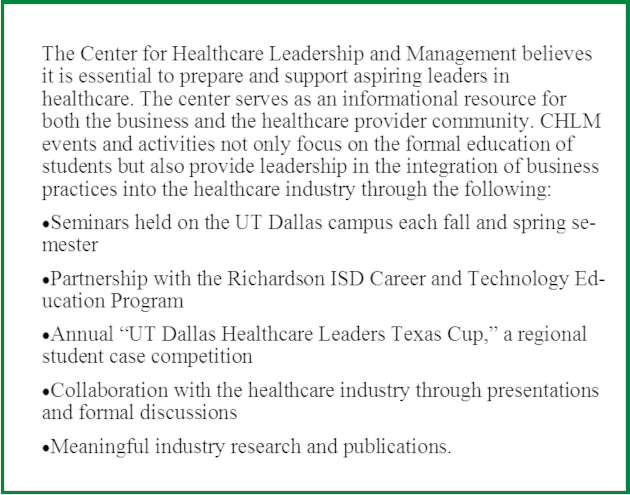
As part of its mission to equip students to become the next generation of healthcare leaders, the Center for Healthcare Leadership and Management at the Naveen Jindal School of Management frequently sponsors events that illuminate the biggest issues the healthcare industry faces. On Oct. 4, the CHLM focused on the challenges employers face in providing affordable healthcare insurance to their employees in a panel discussion, “How Employers are Responding to the Rising Costs of Healthcare.”
An audience of approximately 100 physicians, healthcare leaders, students, faculty and attended the discussion, which was moderated by Dr. Britt Berrett, director of the CHLM.
Dr. John McCracken, executive director of the Alliance for Medical Management Education, a partnership program between the Jindal School and UT Southwestern Medical Center that trains physicians in healthcare leadership and management, set the stage. He provided an analysis that revealed how much costs have risen in the past two decades for the 157.5 million American employees who obtain healthcare coverage through employer-based plans.

The rate of family premiums has grown considerably faster than the consumer price index, according to McCracken. Even though this growth rate has slowed since about 2012, it is still growing at twice the rate of inflation.
“That’s the big challenge facing employers,” he said. There’s no prospect that the gap is going to narrow any time soon. In fact, it’s projected to widen.”
Employers have made efforts during the past several years to rein in costs by implementing measures such as pairing high employee deductibles with healthcare savings plans, telehealth options for mental healthcare and incentives to encourage healthy behaviors. According to McCracken, there are diminishing returns to seeking additional cost-saving measures through these traditional methods.
“The gap between what healthcare cost growth would have been [without these cost-saving measures] and what it actually was has narrowed,” McCracken said. “Essentially, most of the juice to squeeze has been obtained.”

David W. Toomey, senior vice president of the Enterprise division at Sharecare Inc., a health and wellness platform for consumers, detailed why healthcare costs are rising and continue to do so. He explained that waste accounts for about 30 percent of its costs and offered ideas related to the supply chain management process as a solution.
“You pay the bills,” he said, referring to employers. “Six Sigma, Lean — where are [the providers’] variation in the process of care, and how do you embrace those suppliers — physicians and hospitals — [that are] thinking differently about healthcare?”
He explained that employers have the power to reduce waste by rewarding high-performing physicians and hospitals that embrace quality with their continued business. Those low-performing providers that lose business, he said, would then step up by changing their process of care.

Mark Haerr, administrative vice president of administrative operations and compliance at Dallas Area Rapid Transit, rounded out the discussion by offering the employer’s perspective on reducing healthcare costs. Haerr helped lead DART’s efforts to set up a partnership with Baylor Scott & White Quality Alliance to provide healthcare coverage to its 3,600 employees and families.

“We have an arrangement with them that’s mutually beneficial in terms of risk and cost share,” he said.
This type of coverage typically involves more coordination between providers and suppliers than is typically found in traditional arrangements between employers and healthcare coverage providers. But doing so helps reduce inefficiencies and drives down costs.
“We can communicate and educate our employees,” Haerr said. “If you [get] the sniffles on the weekend, don’t go to an emergency room — maybe go to an urgent care.”
Since their arrangement with BSWQA is a closed network, DART also offers an open-access plan that allows employees to see any physician. Future efforts include looking into bundled payments for procedures such as knee and hip replacements, outcome-based pricing for pharmacies and possibly contracted onsite clinics.






